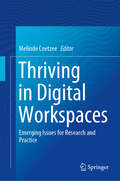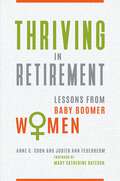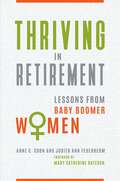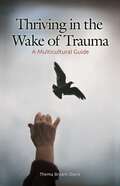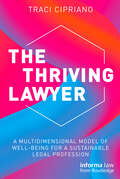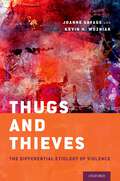- Table View
- List View
Thriving in Digital Workspaces: Emerging Issues for Research and Practice
by Melinde CoetzeeThis edited volume focuses on innovative solutions to the debate on human thriving in the fast emerging technology-driven cyber-physical work context, also called Industry 4.0. The volume asks the important question: How can people remain relevant and thrive in workplaces that are increasingly virtual, technology-driven, and imbued with artificial intelligence? This volume includes two major streams of discussion: it provides multidisciplinary perspectives on what thriving could mean for individuals, managers and organisations in current and future non-linear and Web-driven workspaces. In this context, it points to the need to rethink the curricula of the psychology of human thriving so that it is applicable to Industry 4.0. Second, it discusses the new platforms of learning opening up in organisations and the ways and means with which people's learning practices can be adapted to changing scenarios. Some of these scenarios are: changing job designs and talent requirements; the demand for creativity; the need for virtual teams and intercultural collaborations; and changing emotional competencies. This topical volume includes contributions by scholars from across the world, and is of interest to scholars, practitioners and postgraduate students of psychology, organizational behaviour and human resource management.
Thriving in Retirement: Lessons from Baby Boomer Women
by Anne C. Ph.D. Judith Ann FeuerhermThis important book shares insights derived from surveys, interviews, and focus groups conducted with a diverse group of first-wave Baby Boomer female professionals (born 1946–1956). These individuals changed the workplace in the 1970s and are now changing views of retirement.In Thriving in Retirement: Lessons from Baby Boomer Women, profiles of highly diverse professional women are interwoven with information gleaned from surveys, interviews, and focus groups, thereby allowing readers to identify with individuals similar to themselves, whether through profession, education, personal concerns, or demographics. In spite of dissimilarities in backgrounds, career paths, and personal experiences, these women have much in common. As they leave their full-time careers, they are committed to exploring new post-career identities while finding ways to stay engaged, share their professional expertise, and develop deeply held personal interests and passions they may have set aside in the past. The Baby Boomer women profiled here reveal details such as the early influences on their education and career choices, the aspects of their careers they enjoyed the most, the opportunities and roadblocks they encountered, as well as how they balanced marriage and family responsibilities with their careers. Readers will benefit from the examples set by these women, whose diversity and varying experiences provide inspiration for nearly anyone of retirement age who finds herself wondering "What's next?"
Thriving in Retirement: Lessons from Baby Boomer Women
by Anne C. Ph.D. Judith Ann FeuerhermThis important book shares insights derived from surveys, interviews, and focus groups conducted with a diverse group of first-wave Baby Boomer female professionals (born 1946–1956). These individuals changed the workplace in the 1970s and are now changing views of retirement.In Thriving in Retirement: Lessons from Baby Boomer Women, profiles of highly diverse professional women are interwoven with information gleaned from surveys, interviews, and focus groups, thereby allowing readers to identify with individuals similar to themselves, whether through profession, education, personal concerns, or demographics. In spite of dissimilarities in backgrounds, career paths, and personal experiences, these women have much in common. As they leave their full-time careers, they are committed to exploring new post-career identities while finding ways to stay engaged, share their professional expertise, and develop deeply held personal interests and passions they may have set aside in the past. The Baby Boomer women profiled here reveal details such as the early influences on their education and career choices, the aspects of their careers they enjoyed the most, the opportunities and roadblocks they encountered, as well as how they balanced marriage and family responsibilities with their careers. Readers will benefit from the examples set by these women, whose diversity and varying experiences provide inspiration for nearly anyone of retirement age who finds herself wondering "What's next?"
Thriving in the Wake of Trauma: A Multicultural Guide (International Contributions in Psychology)
by Thema Bryant-DavisRace, ethnicity, sexual orientation, migration status, religion and many other cultural factors play an important role in recovery from a traumatic event. However, most conventional attempts to help people recover from trauma do not anticipate or address these factors. Here, a psychologist describes how to recognize the cultural issues that need to be considered for healing. She offers vignettes illustrating these issues, as well as activities for traumatized people to regain their sense of self-esteem, safety, strength and calm.
The Thriving Lawyer: A Multidimensional Model of Well-Being for a Sustainable Legal Profession
by Traci CiprianoThe Thriving Lawyer: A Multidimensional Model of Well-Being for a Sustainable Legal Profession is based on an innovative model, grounded in science. This book serves as a resource for promoting well-being and culture-change in the legal community by educating about pertinent issues impacting lawyers, and how to address them. It is a roadmap, highlighting the many over-arching and inter-connected aspects of well-being, and enabling readers to identify and target the issues most relevant to their unique situations. Along with practical strategies, the book provides a big-picture framework, illustrating how the many intersecting individual and organizational factors which influence well-being are all related, yet separate and distinct. The framework provides a foundation for creating change, and where you focus first will depend on the needs, the situation, and any unique challenges faced by you or your organization. The Thriving Lawyer explains why, in addition to self-care, change is needed on the organizational level in terms of workplace culture and policies, as well as normalizing self-care and eradicating stigma. This book is intended to benefit individual lawyers, their organizations, and professionals who support them, by educating, motivating, and promoting self-care and healthy work environments.
The Thriving Lawyer: A Multidimensional Model of Well-Being for a Sustainable Legal Profession
by Traci CiprianoThe Thriving Lawyer: A Multidimensional Model of Well-Being for a Sustainable Legal Profession is based on an innovative model, grounded in science. This book serves as a resource for promoting well-being and culture-change in the legal community by educating about pertinent issues impacting lawyers, and how to address them. It is a roadmap, highlighting the many over-arching and inter-connected aspects of well-being, and enabling readers to identify and target the issues most relevant to their unique situations. Along with practical strategies, the book provides a big-picture framework, illustrating how the many intersecting individual and organizational factors which influence well-being are all related, yet separate and distinct. The framework provides a foundation for creating change, and where you focus first will depend on the needs, the situation, and any unique challenges faced by you or your organization. The Thriving Lawyer explains why, in addition to self-care, change is needed on the organizational level in terms of workplace culture and policies, as well as normalizing self-care and eradicating stigma. This book is intended to benefit individual lawyers, their organizations, and professionals who support them, by educating, motivating, and promoting self-care and healthy work environments.
Thriving on the Front Lines: A Guide to Strengths-Based Youth Care Work
by Bob BertolinoYouth and Family Services (YFS) are part of residential and group homes, schools, social service organizations, hospitals, and family court systems. YFS include prevention, education, positive youth development, foster care, child welfare, and treatment. As YFS has evolved advances in research have brought forth a host of promising new ideas that both complement and expand on the original underpinnings of strengths-based practice. Thriving on the Front Lines represents an articulation of these advancements. Thriving on the Front Lines explores the use of strengths-based practices with those who are "in the trenches," Youth Care Worker (YCWs). Commonly referred to as resident counselors, youth counselors, psychiatric technicians (psych techs), caseworkers, case managers, and house parents or managers, YCWs are on the "front lines," often providing services 24 hours a day. Thriving on the Front Lines is an up-to-date treatise on the pivotal role of YCWs and those who work day in and day out with youth to improve their well-being, relationships, and overall quality of life. Unique aspects of the strengths-based framework provided in Thriving on the Front Lines include: Strengths-based principles informed by five decades of research; Discussion of the importance of using real-time feedback to improve service outcomes and "how to" implement an outcome-orientation; Exploration of Positive Youth Development; Two chapters devoted entirely to strengths-based interventions; An in-depth discussion of how to improve effectiveness through deliberate practice; and, How to develop a strengths-based organizational climate.
Thriving on the Front Lines: A Guide to Strengths-Based Youth Care Work
by Bob BertolinoYouth and Family Services (YFS) are part of residential and group homes, schools, social service organizations, hospitals, and family court systems. YFS include prevention, education, positive youth development, foster care, child welfare, and treatment. As YFS has evolved advances in research have brought forth a host of promising new ideas that both complement and expand on the original underpinnings of strengths-based practice. Thriving on the Front Lines represents an articulation of these advancements. Thriving on the Front Lines explores the use of strengths-based practices with those who are "in the trenches," Youth Care Worker (YCWs). Commonly referred to as resident counselors, youth counselors, psychiatric technicians (psych techs), caseworkers, case managers, and house parents or managers, YCWs are on the "front lines," often providing services 24 hours a day. Thriving on the Front Lines is an up-to-date treatise on the pivotal role of YCWs and those who work day in and day out with youth to improve their well-being, relationships, and overall quality of life. Unique aspects of the strengths-based framework provided in Thriving on the Front Lines include: Strengths-based principles informed by five decades of research; Discussion of the importance of using real-time feedback to improve service outcomes and "how to" implement an outcome-orientation; Exploration of Positive Youth Development; Two chapters devoted entirely to strengths-based interventions; An in-depth discussion of how to improve effectiveness through deliberate practice; and, How to develop a strengths-based organizational climate.
Thriving Under Stress: Harnessing Demands in the Workplace
by Thomas W. Britt Steve M. JexWe have all experienced work conditions that tax our ability to cope. Many of us have experienced these demands for long periods of time and have developed psychological, and even physical, problems. Most employees can also recall times when they have dealt with the stress they were under at work, even coming out stronger. What helps employees to perform well and stay healthy under high levels of stress? What are the factors that distinguish those employees? What are the best ways to recover from a stressful day at work? How can employees proactively address stressors they encounter at work, and how can they move from "coping" to "thriving" in the workplace? Thriving Under Stress illuminates the ways stressful working conditions can produce positive outcomes when employees approach demands in the right way, focus on the meaning and significance of their work, and recover appropriately from stressful working conditions, both during the day and when at home. Britt and Jex encourage employees to view themselves as active constructors of their work environment-capable of proactively addressing the burdens they encounter, instead of becoming passive recipients of work stressors.
Through a Glass Brightly: Using Science to See Our Species as We Really Are
by David P. BarashHuman beings have long seen themselves as the center of the universe, the apple of God's eye, specially-created creatures who are somehow above and beyond the natural world. This viewpoint--a persistent paradigm of our own unique self-importance--is as dangerous as it is false. In Through a Glass Brightly, noted scientist David P. Barash explores the process by which science has, throughout time, cut humanity "down to size," and how humanity has responded. A good paradigm is a tough thing to lose, especially when its replacement leaves us feeling more vulnerable and less special. And yet, as science has progressed, we find ourselves--like it or not--bereft of many of our most cherished beliefs, confronting an array of paradigms lost. Barash models his argument around a set of "old" and "new" paradigms that define humanity's place in the universe. This new set of paradigms range from provocative revelations as to whether human beings are well designed, whether the universe has somehow been established with our species in mind (the so-called anthropic principle), whether life itself is inherently fragile, and whether Homo sapiens might someday be genetically combined with other species (and what that would mean for our self-image). Rather than seeing ourselves through a glass darkly, science enables us to perceive our strengths and weaknesses brightly and accurately at last, so that paradigms lost becomes wisdom gained. The result is a bracing, remarkably hopeful view of who we really are.
Through a Glass Brightly: Using Science to See Our Species as We Really Are
by David P. BarashHuman beings have long seen themselves as the center of the universe, the apple of God's eye, specially-created creatures who are somehow above and beyond the natural world. This viewpoint--a persistent paradigm of our own unique self-importance--is as dangerous as it is false. In Through a Glass Brightly, noted scientist David P. Barash explores the process by which science has, throughout time, cut humanity "down to size," and how humanity has responded. A good paradigm is a tough thing to lose, especially when its replacement leaves us feeling more vulnerable and less special. And yet, as science has progressed, we find ourselves--like it or not--bereft of many of our most cherished beliefs, confronting an array of paradigms lost. Barash models his argument around a set of "old" and "new" paradigms that define humanity's place in the universe. This new set of paradigms range from provocative revelations as to whether human beings are well designed, whether the universe has somehow been established with our species in mind (the so-called anthropic principle), whether life itself is inherently fragile, and whether Homo sapiens might someday be genetically combined with other species (and what that would mean for our self-image). Rather than seeing ourselves through a glass darkly, science enables us to perceive our strengths and weaknesses brightly and accurately at last, so that paradigms lost becomes wisdom gained. The result is a bracing, remarkably hopeful view of who we really are.
Through a Screen Darkly: Psychoanalytic Reflections During the Pandemic
by Ahron FriedbergThis book offers real-time, intimate reflections on Dr. Friedberg’s patients as they struggle with COVID-19 and its disruptive, dispiriting fallout. Through a Screen Darkly identifies the psychological distress caused by the pandemic, examining how the particular elements of COVID-19 – its ability to be spread by those who seem not to have it, its intractability, the long-term uncertainty that it engenders – leave even relatively stable people shaken and unsure of the future. The book examines how, amidst radical uncertainty and the prospect of massive social change, such people learn to become resilient. The main theme of the book is that, of necessity, we learn to adapt. Though we still can only see "darkly," we can call on the resources that we have, as well as those we can reasonably acquire, so as to retain a sense of our dignity and purpose. Through a Screen Darkly examines what is possible now as the pandemic runs its course. It makes no predictions of how all this will ultimately play out, but offers a time capsule of how people have coped with a disease that landed suddenly and that we still do not fully understand. Offering a series of intense encounters with worried, traumatized people, this book will be invaluable to in-training and practicing psychiatrists, as it points to the several possible directions for our national, psychological recovery from the pandemic.
Through a Screen Darkly: Psychoanalytic Reflections During the Pandemic
by Ahron FriedbergThis book offers real-time, intimate reflections on Dr. Friedberg’s patients as they struggle with COVID-19 and its disruptive, dispiriting fallout. Through a Screen Darkly identifies the psychological distress caused by the pandemic, examining how the particular elements of COVID-19 – its ability to be spread by those who seem not to have it, its intractability, the long-term uncertainty that it engenders – leave even relatively stable people shaken and unsure of the future. The book examines how, amidst radical uncertainty and the prospect of massive social change, such people learn to become resilient. The main theme of the book is that, of necessity, we learn to adapt. Though we still can only see "darkly," we can call on the resources that we have, as well as those we can reasonably acquire, so as to retain a sense of our dignity and purpose. Through a Screen Darkly examines what is possible now as the pandemic runs its course. It makes no predictions of how all this will ultimately play out, but offers a time capsule of how people have coped with a disease that landed suddenly and that we still do not fully understand. Offering a series of intense encounters with worried, traumatized people, this book will be invaluable to in-training and practicing psychiatrists, as it points to the several possible directions for our national, psychological recovery from the pandemic.
Through a Trauma Lens: Transforming Health and Behavioral Health Systems
by Vivian Barnett BrownThrough a Trauma Lens aims to understand and highlight successful examples of health, mental health, substance abuse treatment, and other service delivery systems that have implemented an integrated trauma-informed service model. This innovative volume draws on the author’s first-hand experience working alongside a number of local and state organizations as well as a nationwide survey of notable trauma-informed models. Structured around illustrative case studies, chapters that correspond to stage of adoption, and strategies for cultivating staff support, this valuable new resource include examples and strategies to be applied in any treatment or service setting.
Through a Trauma Lens: Transforming Health and Behavioral Health Systems
by Vivian Barnett BrownThrough a Trauma Lens aims to understand and highlight successful examples of health, mental health, substance abuse treatment, and other service delivery systems that have implemented an integrated trauma-informed service model. This innovative volume draws on the author’s first-hand experience working alongside a number of local and state organizations as well as a nationwide survey of notable trauma-informed models. Structured around illustrative case studies, chapters that correspond to stage of adoption, and strategies for cultivating staff support, this valuable new resource include examples and strategies to be applied in any treatment or service setting.
Through Assessment to Consultation: Independent Psychoanalytic Approaches with Children and Adolescents
by Ann HorneWinnicott’s description of "doing something else" or "working as a psychoanalyst" when not engaged in the actual analysis of his patients resonates with the child psychotherapist today. Individual psychotherapy is certainly a valuable part of the work but much of the time the CPT is "doing something appropriate to the occasion". Some of this time is spent in assessment work – for therapy, for the multi-professional team and for other agencies – and some in consultation to colleagues and other professional staff or in a combination of the two. Drawing from the Independent tradition in psychoanalysis, Through Assessment to Consultation explores the application of psychoanalytic thinking to this daily work, reflecting on what is actually done and why. Contributors to the three sections – ‘Assessment’, ‘Overlaps’, ‘Consultation and Beyond’ – provide a variety of clinical illustrations as they describe a range of approaches and settings in the tasks of both assessment and consultation, ranging from the light impact of the analyst’s presence in the grief of post-9/11 New York to the call to political potency of ‘beyond consultation.’ This book will help both new and experienced Child and Adolescent Psychotherapists re-examine their role and function in the team and in the outside world, and will also be of interest to specialist health workers, educational psychologists and those wanting to explore more Winnicottian approaches to therapeutic work.
Through Assessment to Consultation: Independent Psychoanalytic Approaches with Children and Adolescents
by Ann Horne Monica LanyadoWinnicott’s description of "doing something else" or "working as a psychoanalyst" when not engaged in the actual analysis of his patients resonates with the child psychotherapist today. Individual psychotherapy is certainly a valuable part of the work but much of the time the CPT is "doing something appropriate to the occasion". Some of this time is spent in assessment work – for therapy, for the multi-professional team and for other agencies – and some in consultation to colleagues and other professional staff or in a combination of the two. Drawing from the Independent tradition in psychoanalysis, Through Assessment to Consultation explores the application of psychoanalytic thinking to this daily work, reflecting on what is actually done and why. Contributors to the three sections – ‘Assessment’, ‘Overlaps’, ‘Consultation and Beyond’ – provide a variety of clinical illustrations as they describe a range of approaches and settings in the tasks of both assessment and consultation, ranging from the light impact of the analyst’s presence in the grief of post-9/11 New York to the call to political potency of ‘beyond consultation.’ This book will help both new and experienced Child and Adolescent Psychotherapists re-examine their role and function in the team and in the outside world, and will also be of interest to specialist health workers, educational psychologists and those wanting to explore more Winnicottian approaches to therapeutic work.
Through Paediatrics to Psychoanalysis: Collected Papers
by Donald W. WinnicottThe value of Winnicott's work has become more and more widely recognized not only among psycho-analysts but also psychologists, educators, social workers, and men and women in every branch of medicine; indeed, all whose work or practice involves the care of children in health or sickness.An important part of the value of these writings lies in the uniquely binocular view with which the author regards the subjects of his investigation. With him, pediatrics informs psycho-analysis; psycho-analysis illuminates pediatrics. This book is not concerned with innovation in basic psychoanalytic concepts or techniques, but with the formulation and testing-out of ideas whose origin was in the challenge of day-to-day clinical work that was the staple of Winnocott's medical experience throughout his professional life.This book is arranged in three sections. The first represents Winnicott's attitudes as a pediatrician prior to training in psycho-analysis, and demonstrates the degree to which a purely formal pediatric approach requires as an effective complement a deeper understanding of the emotional problems of child development.
Through Paediatrics to Psychoanalysis: Collected Papers
by Donald W. WinnicottThe value of Winnicott's work has become more and more widely recognized not only among psycho-analysts but also psychologists, educators, social workers, and men and women in every branch of medicine; indeed, all whose work or practice involves the care of children in health or sickness.An important part of the value of these writings lies in the uniquely binocular view with which the author regards the subjects of his investigation. With him, pediatrics informs psycho-analysis; psycho-analysis illuminates pediatrics. This book is not concerned with innovation in basic psychoanalytic concepts or techniques, but with the formulation and testing-out of ideas whose origin was in the challenge of day-to-day clinical work that was the staple of Winnocott's medical experience throughout his professional life.This book is arranged in three sections. The first represents Winnicott's attitudes as a pediatrician prior to training in psycho-analysis, and demonstrates the degree to which a purely formal pediatric approach requires as an effective complement a deeper understanding of the emotional problems of child development.
Through the Eyes of Aliens: A Book about Autistic People
by Jasmine Lee O'NeillThis is a positive description of how it feels to be autistic and how friends, family and professionals can be more sensitive to the needs of autistic people. Lee O'Neill perceives the imagination and keenly-felt sensory world of the autistic person as gifts. She challenges the reader to accept their difference and celebrate their uniqueness.
Through the Language Glass: Why The World Looks Different In Other Languages
by Guy Deutscher"Guy Deutscher is that rare beast, an academic who talks good sense about linguistics... he argues in a playful and provocative way, that our mother tongue does indeed affect how we think and, just as important, how we perceive the world." Observer*Does language reflect the culture of a society? *Is our mother-tongue a lens through which we perceive the world? *Can different languages lead their speakers to different thoughts? In Through the Language Glass, acclaimed author Guy Deutscher will convince you that, contrary to the fashionable academic consensus of today, the answer to all these questions is - yes. A delightful amalgam of cultural history and popular science, this book explores some of the most fascinating and controversial questions about language, culture and the human mind.
Through the Models of Writing (Studies in Writing #9)
by D. Alamargot L. ChanquoyThis book provides both young and senior scientists with a comparative view of current theoretical models of text production. Models are clearly situated in their historical context, scrutinized in their further evolution with a fine-grained observation of differences between models. Very complete and informative to read, this book will be useful to people working in teaching of writing or studying this specific human activity.
Through Windows of Opportunity: A Neuroaffective Approach to Child Psychotherapy
by Marianne BentzenResearch has shown that nonspecific factors such as relationship and personality have a stronger correlation to outcome than method. The basic argument of Through Windows of Opportunity is that skilled psychotherapists do similar things while describing them differently, and that psychological healing is created in the context of relationship. This book presents the work of four therapists: Peter Levine from the USA (working with with Somatic Experiencing on trauma states); Jukka Makela from Finland (with Theraplay, working with disorganized attachment); Haldor Ovreeide from Norway (with a therapeutic conversation in a disrupted son-mother dyad); and Eia Asen from the London Marlborough Clinic (with systemic and mentalization-based family therapy working on a dependent attachment pattern). The closing chapters of the book summarize the high points of the discussions among the four therapists about nonspecific but shared aspects of their interventions, moderated by the authors.
Through Windows of Opportunity: A Neuroaffective Approach to Child Psychotherapy
by Marianne BentzenResearch has shown that nonspecific factors such as relationship and personality have a stronger correlation to outcome than method. The basic argument of Through Windows of Opportunity is that skilled psychotherapists do similar things while describing them differently, and that psychological healing is created in the context of relationship. This book presents the work of four therapists: Peter Levine from the USA (working with with Somatic Experiencing on trauma states); Jukka Makela from Finland (with Theraplay, working with disorganized attachment); Haldor Ovreeide from Norway (with a therapeutic conversation in a disrupted son-mother dyad); and Eia Asen from the London Marlborough Clinic (with systemic and mentalization-based family therapy working on a dependent attachment pattern). The closing chapters of the book summarize the high points of the discussions among the four therapists about nonspecific but shared aspects of their interventions, moderated by the authors.
Thugs and Thieves: The Differential Etiology of Violence
by Joanne Savage Kevin H. WozniakIt's often assumed that criminologists know a great deal about violent offenders, but in fact, there is little consensus about what distinguishes them from those who commit less serious crimes. There is even less agreement about whether violent offenders can be distinguished from chronic, nonviolent offenders at all. The challenging question remains: why do some individuals commit violent offenses while so many others restrict themselves to nonviolent ones? Thugs and Thieves argues that understanding the differential etiology of violence constitutes a fundamental chasm in the criminological literature. In the introductory chapters, the authors lay out the important theoretical and methodological deficiencies that have obstructed the production of a clear set of findings to answer this question. The authors then share a highly nuanced interpretation of child development research, focused on outlining important features of early life likely to be important in the etiology of serious physical aggression and violence. They also discuss criminal motivation and contextual factors in detail. Together, these lay the foundation for the selection of "good prospects" for predicting violent offending. Separate chapters are devoted to intelligence and executive function; academic achievement and other school factors; parental attachment; parental warmth and rejection; child abuse; poverty; communities; and substance abuse. Each chapter provides a comprehensive and systematic review of the existing evidence on the topic at hand through the "differential etiology" lens, to restructure what we already know from the empirical literature. As such, the book provides a new way forward for understanding this important issue and also serves as a platform for generating hypothesis tests, directing future research, and better designing anti-violence policy. Thugs and Thieves will be of interest to criminologists, psychologists, sociologists, students, policy makers, lawmakers, and readers interested in violence and aggression.
